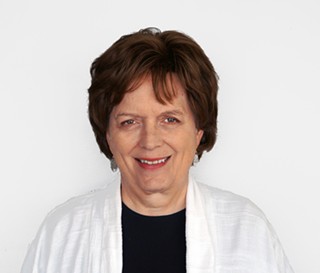There were plenty of heated discussions when Georges-Pierre Seurat began displaying his controversial paintings in late-19th-century France. These conflicts, and the intense obsession needed to create the works themselves, are the fuel for Sunday in the Park With George, now being given a stellar production at Lakeland Theatre. This languorous but enthralling show, with music and lyrics by Stephen Sondheim, explores the intense interior life of a driven artist as well as the pressures that conspire to turn artists into high-class panhandlers -- scrounging for grants and patrons to continue their work.
Seurat was a master of pointillism, which uses the precise placement of painted dots to create remarkable vibrancy and luminosity. Having studied the science of color theory, Seurat applied a panoply of colored points that blended in the eye and brain of the viewer, creating a representational image.
Sondheim and book author James Lapine use a similar technique in the first act, theatrically delving point-by-point into Seurat's process for painting his masterwork, "Sunday Afternoon on the Island of La Grande Jatte." Communing constantly with his paints and not his model and lover (inevitably named Dot), George issues only directions such as "Don't lift the arm, please" and "Don't move." While Dot stands patiently in the sun, she complains in the title song about her thankless task ("The collar is damp/Beginning to pinch/The bustle is slipping").
Trees move on- and offstage with a wave of George's hand as he tries to "bring order to the whole." Various people who appear in the actual painting arrive in the park (including George's crotchety mother), and we get a sense of the painting coming together, even as George and Dot's relationship is falling apart. Oblivious to her needs back at their flat, he is musically focused on "Finishing the Hat" of a person on the canvas while she simmers, waiting to go out for the evening.
The determinedly inventive score by Sondheim, seemingly as fragmented as Seurat's color scheme, imposes many demands on the Lakeland cast. But, under the sure guidance of director Martin Friedman and musical director Larry Goodpaster, both the melodic and verbal wit of these songs comes alive. As Dot, Amiee Collier has the natural affect of a plain girl who got hooked up with a genius and feels a bit out of her depth. But she has enough backbone to proceed with her life and not be further victimized by George's artistic monomania. Collier also delivers a cleverly underplayed Grandma Marie in later scenes.
Fortunately, this production uses the painted drops and cutouts from the national touring production, enabling Seurat's work to be presented in the manner originally intended. Indeed, when the first act ends and the actors assemble to create a live tableau of the painting that hangs from above, the effect is mesmerizing.
In Act Two, however, everything changes, and we are swept forward a century or so, as George's great-grandson is presenting his laser art show titled "Chromolume #7." Just as iconoclastic as his ancestor, this George is embroiled in the snarky politics of the art scene. This is expressed in the long and daunting song "Putting It Together," which weaves interior monologue and exterior dialogue into a scathing satire of the superficial and fickle art world. As George psychs himself to glad-hand potential benefactors ("Say cheese, George/And put them at their ease, George"), he has to face the ultimate irony: "Advancing art is easy/Financing it is not."
Eventually, 20th-century George winds up back in France, at the site of the original painting. And it is there, with the help of Dot's old grammar book, that he reconnects with his artistic mission, expressed in the touching song "Move On."
Andrew Tarr is a committed and believable George (in both acts). Although he lacks the haunted and piercing stare of Seurat, Tarr has a clear and crisp tenor that matches this material well. And some of the accumulating pain that eludes him in the marathon of "Putting It Together" will no doubt develop during the run of the show. In a consistently strong cast, Mary Jane Nottage stands out, first as George's tart mother and later as an art critic.
This production hits virtually all the right buttons as it explores art as science, art as commerce, and human connectedness in a variety of ways. Plus, it's a detailed tour of an artist's mind at work -- and that makes for a damn fascinating evening.












